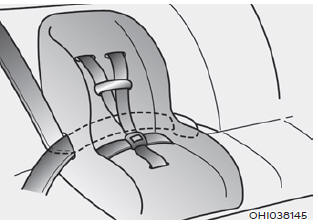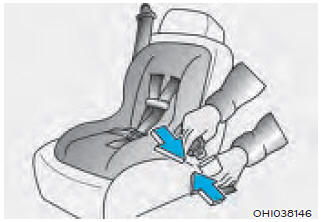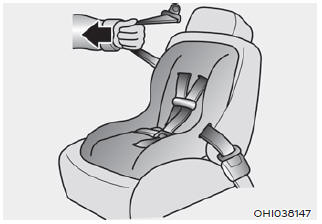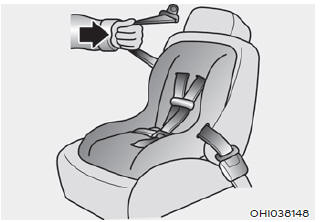Hyundai Santa Cruz: Installing a Child Restraint System (CRS) / Securing a Child Restraint System with a lap/shoulder belt
WARNING
ALWAYS place a rearward-facing Child Restraint System in the rear seat of the vehicle.
Placing a rearward-facing child restraint in the front seat can result in serious injury or death if the Child Restraint System is struck by an inflating air bag.
When not using the LATCH system, all Child Restraint Systems must be secured to a rear seat with the lap part of a lap/ shoulder belt.

Automatic locking mode
Since all passenger seat belts move freely under normal conditions and only lock under extreme or emergency conditions (emergency locking mode), you must manually pull the seat belt all the way out to shift the retractor to the "Automatic Locking" mode to secure a Child Restraint System.
The "Automatic Locking" mode will help prevent the normal movement of the child in the vehicle from causing the seat belt to loosen and compromise the Child Restraint System. To secure a Child Restraint System, use the following procedure.
To install a Child Restraint System on the rear seats, do the following:
1. Place the Child Restraint System on a rear seat and route the lap/shoulder belt around or through the Child Restraint System, following the Child Restraint System manufacturer’s instructions. Make sure the seat belt webbing is not twisted.
Information
When using the rear center seat belt, you should also refer to the "Rear Seat Belt – Passenger's 3-point system" section in this chapter.

2. Fasten the lap/shoulder belt latch into the buckle. Listen for the distinct “click” sound.
Information
Position the release button so that it is easy to access in case of an emergency.

3. Pull the shoulder portion of the seat belt all the way out. When the shoulder portion of the seat belt is fully extended, it will shift the retractor to the "Automatic Locking" (child restraint) mode.

4. Slowly allow the shoulder portion of the seat belt to retract and listen for an audible "clicking" or "ratcheting" sound. This indicates that the retractor is in the "Automatic Locking" mode. If no distinct sound is heard, repeat steps 3 and 4.
5. Remove as much slack from the belt as possible by pushing down on the Child Restraint System while feeding the shoulder belt back into the retractor.
6. Push and pull on the Child Restraint System to confirm that the seat belt is holding it firmly in place. If it is not, release the seat belt and repeat steps 2 through 6.
7. Double check that the retractor is in the "Automatic Locking" mode by attempting to pull more of the seat belt out of the retractor. If you cannot, the retractor is in the "Automatic Locking" mode.
If your Child Restraint System manufacturer instructs or recommends you to use a tether anchor with the lap/ shoulder belt, refer to the previous pages for more information.
Information
When the seat belt is allowed to retract to its fully stowed position, the retractor will automatically switch from the “Automatic Locking” mode to the emergency lock mode for normal adult usage.
WARNING
If the retractor is not in the “Automatic Locking” mode, the child restraint can move when your vehicle turns or stops suddenly. A child can be seriously injured or killed if the child restraint is not properly anchored in the car, including manually pulling the seat belt all the way out to shift the retractor to the “Automatic Locking” mode.
To remove the Child Restraint System, press the release button on the buckle and then pull the lap/shoulder belt out of the Child Restraint System and allow the seat belt to retract fully.
WARNING
If a child restraint is installed in the second row center seat, move the second row seat far back as possible, to minimize contact with the front center air bag.
 Securing a Child Restraint System
seat with “Tether Anchor” system
Securing a Child Restraint System
seat with “Tether Anchor” system
First secure the child restraint with
the LATCH lower anchors or the seat
belt. If the child restraint manufacturer
recommends that the top tether strap
be attached, attach and tighten the
top t ...
 Air Bag - Supplemental Restraint system
Air Bag - Supplemental Restraint system
1. Driver’s front air bag
2. Passenger’s front air bag
3. Side air bag
4. Curtain air bag
This vehicle is equipped with a Supplemental Air Bag System for the driver’s
seat and
front passenger ...
Other information:
Hyundai Santa Cruz 2021-2025 Owners Manual: Lane Following Assist (LFA)
Lane Following Assist is designed to
detect lane markings on the roadway
and/or a vehicle directly in front and
automatically provides steering inputs
to help keep your vehicle centered in the
lane or following the vehicle in front of
you.
Detecting sensor
[1] : Front view camera
The front vi ...
Hyundai Santa Cruz 2021-2025 Owners Manual: Remote Start
You can start the vehicle using the
Remote Start button of the smart key.
To start the vehicle remotely:
1. Press the door lock button within 32
feet (10 m) from the vehicle.
2. Press and hold the remote start button
() within 4 seconds after pressing
the Door Lock button on the remote.
3. To t ...
